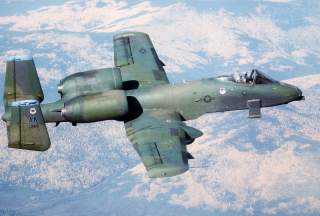How the A-10 Warthog Could Become North Korea's Worst Nightmare
This plane needs to stick around.
The A-10 was originally designed and deployed to support NATO forces against a land attack coming from the Soviet Union.
The much-maligned A-10 Thunderbolt ground attack airplane could prove to be a savior if fighting breaks out with North Korea. However, the US Air Force wants to get rid of the plane, and is not asking for funds to fix the wings on some 100 A-10s, which therefore may end up in the scrap yard.
In any conflict with North Korea, a US-South Korean-Coalition’s objective will be to knock out North Korea’s nuclear facilities and missiles. This will surely involve strategic bombers and maybe even stealth aircraft. But one immediate consequence will be that North Korea will attack South Korea, probably aiming first at neutralizing US and Korean forces by destroying bases, airfields, depots and equipment.
This first appeared in January 2018.
North Korea has a very large army that may number 3.5 million men and women, although the quality of the forces is open to question and skepticism. The country also has a considerable armored capability. There are 4,200 tanks, 2,200 armored personnel carriers, 8,600 artillery pieces and 4,800 multiple rocket launchers. While most of these are of old designs, if North Korea is able to move them in position, cross the DMZ and mount an attack on the south, its army could quickly defeat the south.
Recommended: How North Korea Could Start a War
Recommended: This Is What Happens if America Nuked North Korea
Recommended: The Colt Python: The Best Revolver Ever Made?
But if that is what the North Koreans are betting on, they had better be ready for US airpower. And the aircraft that could cause them the most harm is the A-10.
The A-10 was originally designed and deployed to support NATO forces against a land attack coming from the Soviet Union. It was purposely built to be able to knock out tanks, APCs and other mobile hardware.
A Soviet attack never came and the Soviet Union disintegrated by 1991. Consequently the A-10 was repurposed to perform COIN (counterinsurgency) duties and was used heavily in Afghanistan and Iraq. Not only was it used to blast away at Taliban and al-Qaeda, and more recently ISIS formations, but it also played an important role in offering close support to advancing coalition forces.
But the threat from North Korea of a massive land attack is no different than the one that was feared from the USSR. The A-10 design is perfectly suited to the mission.
The heart of the A-10 is its formidable and highly effective GAU-8 30mm canon. The GAU-8, termed the “Avenger,” is a 7-barrel gatling gun that can fire 4,200 rounds per minute. It carries two types of ammunition: an armor piercing shell that uses a depleted uranium core, and an incendiary shell. It could take out any and all of North Korea’s armor.
The US Air Force has been trying to kill the A-10 program. It claims (among other things) that existing aircraft can fill its role (argument 1) and that the plane is not survivable in complex environments where the enemy has real air defenses (argument 2).
Of course, when the A-10 was built and first deployed, the adversary had air defenses in depth. These were shown off by Egypt and Syria in the 1973 Yom Kippur war, where fighting, especially in the Sinai, was a clash of large armies and where air power was crucial to Israel’s ability to blunt the Egyptian attack and turn the war around.
Israel’s Air Force faced SA-6 air defense missiles coupled with ZSU Quad 4 23mm guns. Both were mobile and could move with the Egyptian armored force. In seeking to knock them out, Israel used A-4s and had a tough time, losing many aircraft (mostly to the ZSU guns). Most of the time the losses happened when the A-4s were pulling away from an attack and got shot up when they were most vulnerable.
North Korea has fairly modern air defenses, especially a system known as the S-75 and another called the KN-06. The S-75 is more or less the same things as the Russian SA-2. The KN-06 is thought to be an early version of the Russian S-300, but manufactured locally.
These systems are great targets for the F-35 or F-22, or they can be jammed and knocked out by long range bombers such as the B-1.
The argument the Air Force carefully avoids is that US aircraft don’t operate singularly. The F-22 is a strategic long-range pure stealth fighter bomber; the F-35 is a new tactical stealth plane that can play a role against North Korean missile sites. Much of North Korea’s largely obsolete Air Force is food for F-15s and F- 16s.
While nothing ever works exactly as advertised, combinations of coalition aircraft can keep the skies clear and go to work on the main strategic targets (long range missiles and nuclear facilities), leaving the A-10 with a prime role of blasting North Korea’s armored forces.
The A-10 is the perfect aircraft to blast any plans Kim Jong-un has to dominate the Korean peninsula. If his army is chopped up and decimated, he will only have himself to blame. And if he survives, he will remember the A-10.
This first appeared in AsiaTimes here.
Image: Wikimedia

